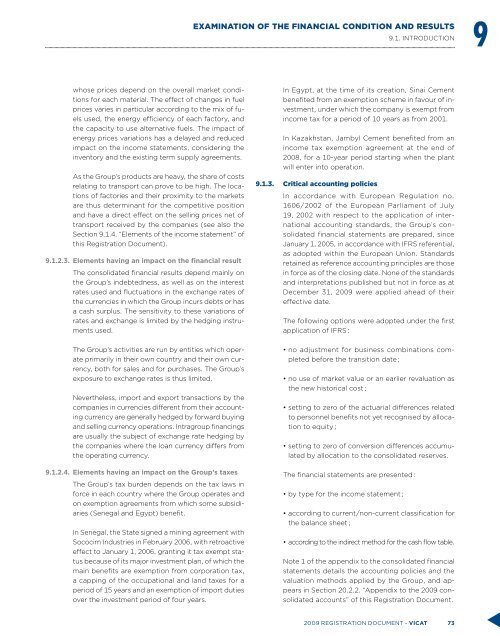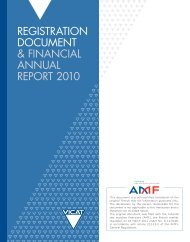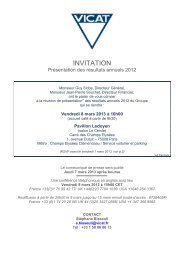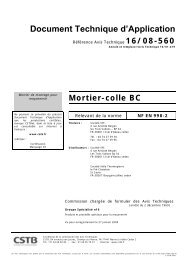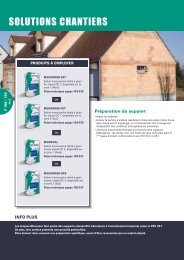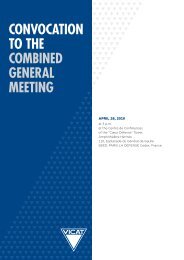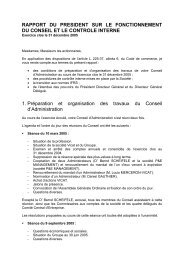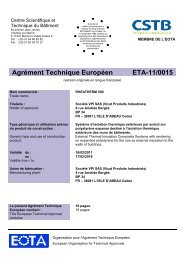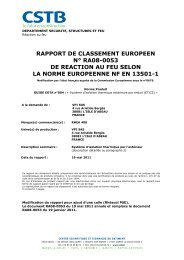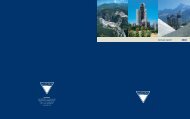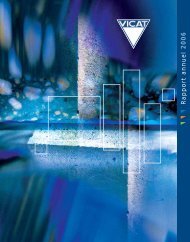6 - Vicat
6 - Vicat
6 - Vicat
- No tags were found...
Create successful ePaper yourself
Turn your PDF publications into a flip-book with our unique Google optimized e-Paper software.
EXAMINATION OF THE FINANCIAL CONDITION AND RESULTS9 9.1. INTRODUCTIONwhose prices depend on the overall market conditionsfor each material. The effect of changes in fuelprices varies in particular according to the mix of fuelsused, the energy efficiency of each factory, andthe capacity to use alternative fuels. The impact ofenergy prices variations has a delayed and reducedimpact on the income statements, considering theinventory and the existing term supply agreements.As the Group’s products are heavy, the share of costsrelating to transport can prove to be high. The locationsof factories and their proximity to the marketsare thus determinant for the competitive positionand have a direct effect on the selling prices net oftransport received by the companies (see also theSection 9.1.4. “Elements of the income statement” ofthis Registration Document).9.1.2.3. Elements having an impact on the financial resultThe consolidated financial results depend mainly onthe Group’s indebtedness, as well as on the interestrates used and fluctuations in the exchange rates ofthe currencies in which the Group incurs debts or hasa cash surplus. The sensitivity to these variations ofrates and exchange is limited by the hedging instrumentsused.The Group’s activities are run by entities which operateprimarily in their own country and their own currency,both for sales and for purchases. The Group’sexposure to exchange rates is thus limited.Nevertheless, import and export transactions by thecompanies in currencies different from their accountingcurrency are generally hedged by forward buyingand selling currency operations. Intragroup financingsare usually the subject of exchange rate hedging bythe companies where the loan currency differs fromthe operating currency.9.1.2.4. Elements having an impact on the Group’s taxesThe Group’s tax burden depends on the tax laws inforce in each country where the Group operates andon exemption agreements from which some subsidiaries(Senegal and Egypt) benefit.In Senegal, the State signed a mining agreement withSococim Industries in February 2006, with retroactiveeffect to January 1, 2006, granting it tax exempt statusbecause of its major investment plan, of which themain benefits are exemption from corporation tax,a capping of the occupational and land taxes for aperiod of 15 years and an exemption of import dutiesover the investment period of four years.In Egypt, at the time of its creation, Sinai Cementbenefited from an exemption scheme in favour of investment,under which the company is exempt fromincome tax for a period of 10 years as from 2001.In Kazakhstan, Jambyl Cement benefited from anincome tax exemption agreement at the end of2008, for a 10-year period starting when the plantwill enter into operation.9.1.3. Critical accounting policiesIn accordance with European Regulation no.1606/2002 of the European Parliament of July19, 2002 with respect to the application of internationalaccounting standards, the Group’s consolidatedfinancial statements are prepared, sinceJanuary 1, 2005, in accordance with IFRS referential,as adopted within the European Union. Standardsretained as reference accounting principles are thosein force as of the closing date. None of the standardsand interpretations published but not in force as atDecember 31, 2009 were applied ahead of theireffective date.The following options were adopted under the firstapplication of IFRS :• no adjustment for business combinations completedbefore the transition date ;• no use of market value or an earlier revaluation asthe new historical cost ;• setting to zero of the actuarial differences relatedto personnel benefits not yet recognised by allocationto equity ;• setting to zero of conversion differences accumulatedby allocation to the consolidated reserves.The financial statements are presented :• by type for the income statement ;• according to current/non-current classification forthe balance sheet ;• according to the indirect method for the cash flow table.Note 1 of the appendix to the consolidated financialstatements details the accounting policies and thevaluation methods applied by the Group, and appearsin Section 20.2.2. “Appendix to the 2009 consolidatedaccounts” of this Registration Document.2009 registration document - VICAT 73


